
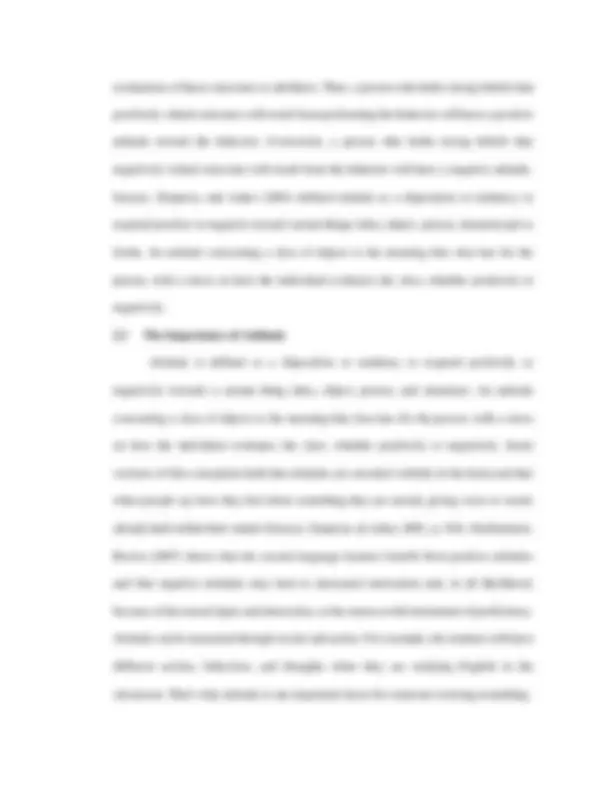
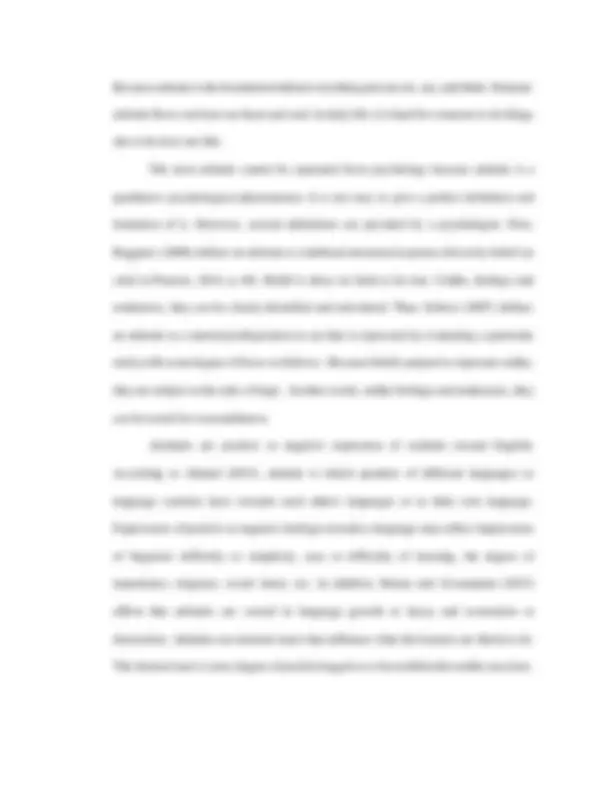
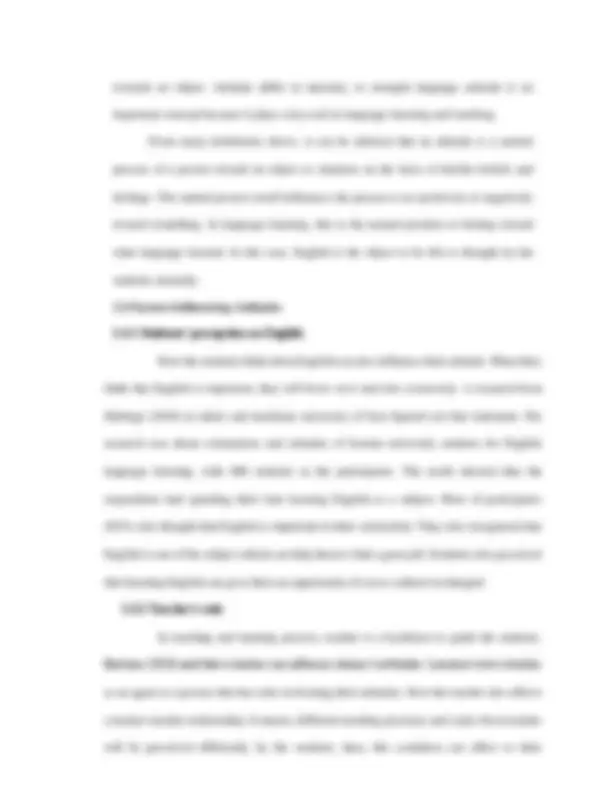
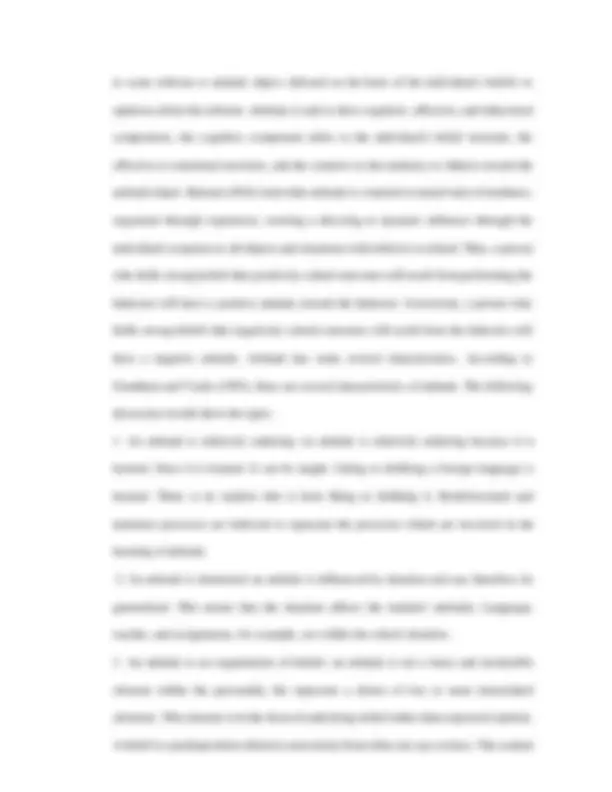
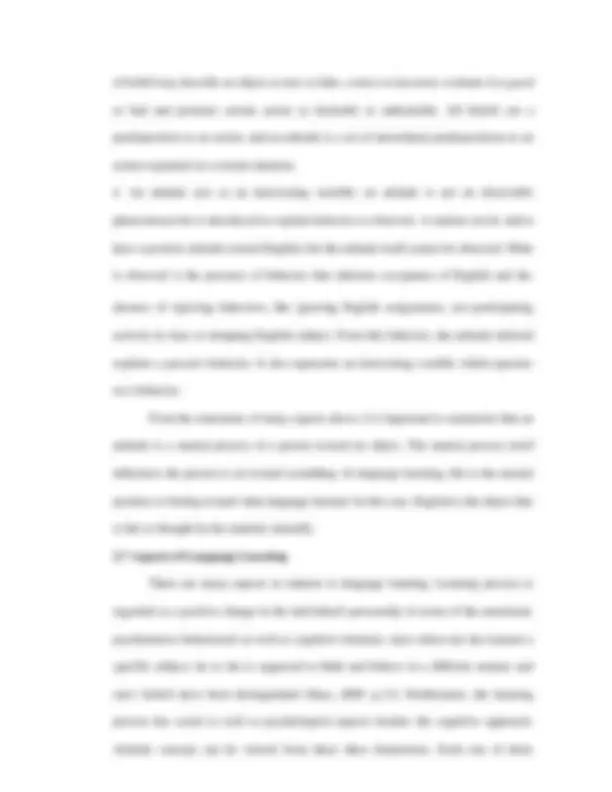
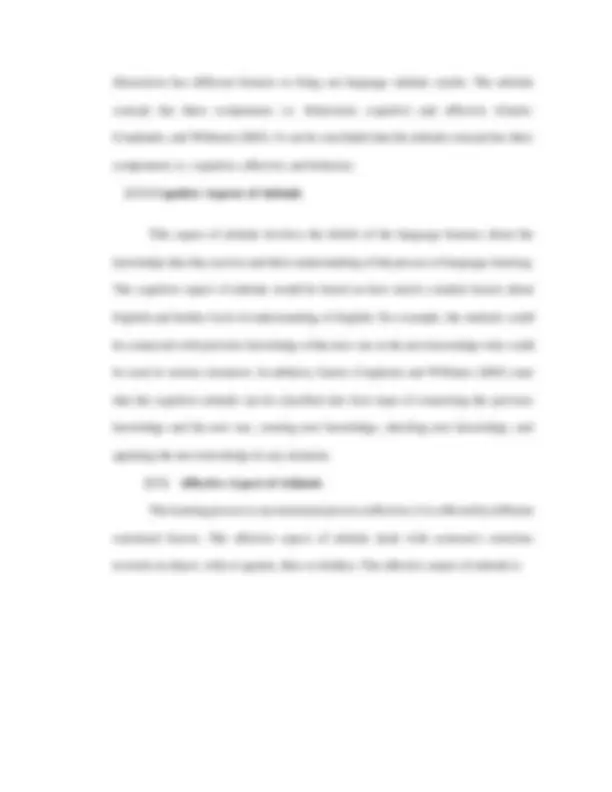
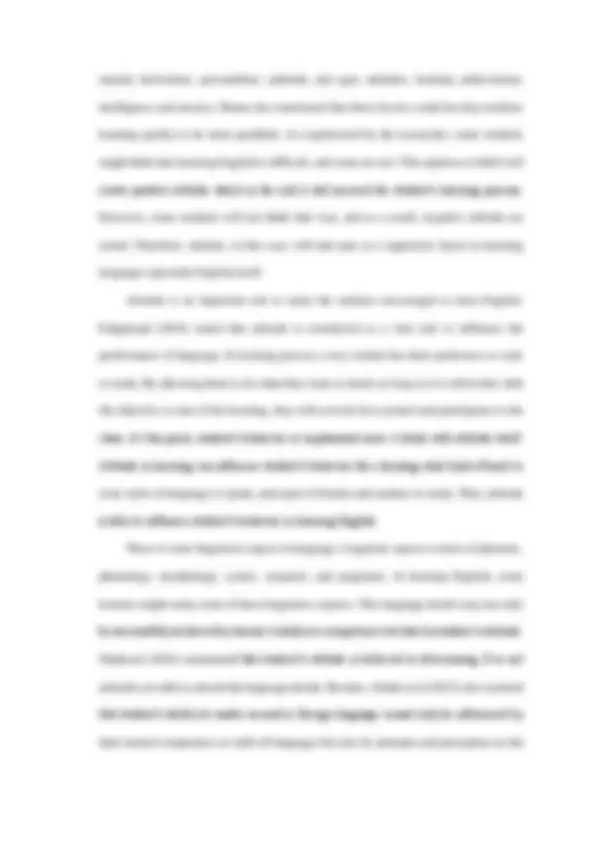

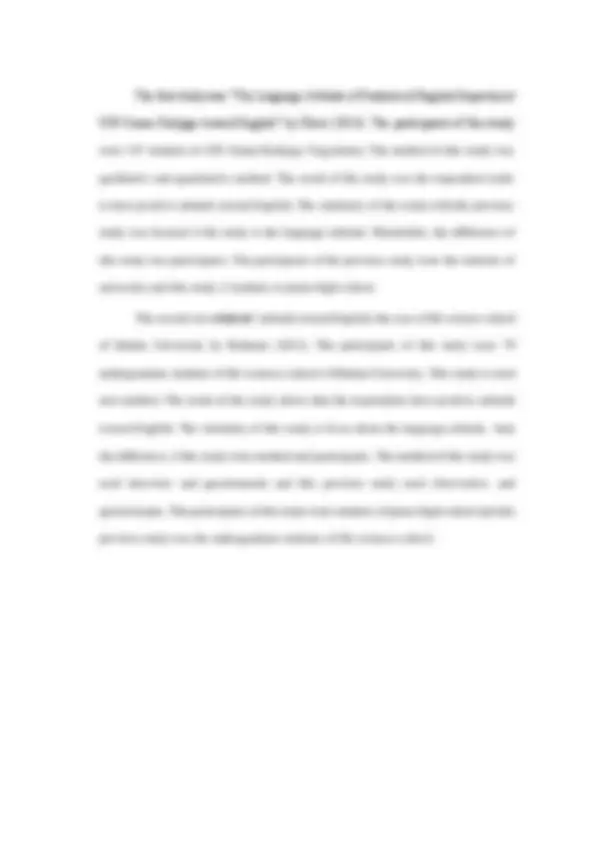


Study with the several resources on Docsity

Earn points by helping other students or get them with a premium plan


Prepare for your exams
Study with the several resources on Docsity

Earn points to download
Earn points by helping other students or get them with a premium plan
Community
Ask the community for help and clear up your study doubts
Discover the best universities in your country according to Docsity users
Free resources
Download our free guides on studying techniques, anxiety management strategies, and thesis advice from Docsity tutors
The term attitude cannot be separated from psychology because attitude is a qualitative psychological phenomenon. It is not easy to give a perfect definition ...
Typology: Study Guides, Projects, Research
1 / 15

This page cannot be seen from the preview
Don't miss anything!










This chapter presents: (1) the concept of Attitude, (2) types of attitude, (3) factors influencing attitude, (4) the importance of attitude, and (5) previous related study. 2.1 Definition of Attitude Attitude is related to thoughts as well as to feelings and emotions. According to Cystal (1997), attitudes are the feelings people have about their own language or the languages of others. Thus, attitude to language is a construct that explains linguistic behavior in particular. Allport (1935) defines that attitude is a mental or neural state of readiness, organized through experience, exerting a directive or dynamic influence upon the individual’s response to all objects and situation with which it is related (as cited in Baker, 1992, p. 11). Attitude is a convenient and efficient way of explaining consistent patterns in behavior. It often manages to summarize, explain and predict behavior (Baker, 1992, p. 52). It means that someone attitude toward something can be seen from the way they say, and act related to the attitude object. Attitude imply evaluation, which is usually done a bipolar continuum from favorable to unfavorable, or from positive to negative, that could comprise attributes such as good-bad, harmful-beneficial, pleasant-unpleasant, and likeable-dislikeable (Azjen, 2001, p. 126). In addition, Eiser (2004) claims that these evaluations are related to a specific object, they are not “free floating”, but have a quality of “about ness”. The attitude object can be any entity discriminated by the individual, from concrete objects through abstract ideas, persons, events and behaviors (Eagly, 1992 ; Maio & Haddock,
2004 ; Pratkanis & Greenwald, 1989). It can be concluded that attitude is related to thoughts as well as to feelings and emotions. 2.2. The Concept of Attitude Attitude is one of basic when the students want to master the language. In learning English and mastering the language, the students should have basics, namely; interest, motivation, and attitude. The word attitude, which comes from the Latin word "Optus" meaning suitability or adaptation, means behavior, state, and line of conduct. Kartubi mentioned that there exist different definitions of the term "Attitude", which is characterized as learned tendencies that prompt an individual to exhibit certain behaviors in front of certain people, times and situations. In addition, Ünal and Işeri (2012) said attitude is the state of emotional and mental preparation, which is formed through experiences, that has a directive or dynamic influential power on an individual's behaviors towards all things and situations. Attitude is "a word used as a general tendency of an individual tendency to act in a certain condition". The use of word attitude is based on what someone says, or someone does and is based on visible behavior. It means that someone attitude toward something can be seen from the way they say and activities related to the attitude object. Attitudes are what the people thinking or feeling about something. Ricards and Schimidth (2003) mention that attitudes are the opinions and feelings that one usually has about something or someone. They can be positive or negative. Montano and Kasprzyk (2008) state that attitude is determined by the individual's beliefs about outcomes or attributes of performing the behavior (behavior beliefs), weighted by
Because attitude is the foundation behind everything persons do, say, and think. Humans' attitude flows out from our heart and soul. In daily life, it is hard for someone to do things she or he does not like. The term attitude cannot be separated from psychology because attitude is a qualitative psychological phenomenon. It is not easy to give a perfect definition and limitation of it. However, several definitions are provided by a psychologist. First, Ruggiero (2008) defines an attitude as a habitual emotional response driven by belief (as cited in Pratono, 2014, p. 48). Belief is ideas we hold to be true. Unlike, feelings and tendencies, they can be clearly identified and articulated. Then. Schwrz (2007) defines an attitude as a mental predisposition to act that is expressed by evaluating a particular entity with some degree of favor or disfavor. Because beliefs purport to represent reality, they are subject to the rules of logic. In other words, unlike feelings and tendencies, they can be tested for reasonableness. Attitudes are positive or negative expression of students toward English. According to Ahmed (2015), attitude is which speakers of different languages or language varieties have towards each other's languages or to their own language. Expressions of positive or negative feelings towards a language may reflect impressions of linguistic difficulty or simplicity, ease or difficulty of learning, the degree of importance, elegance, social status, etc. In addition, Ibnian and Al-amadani (2015) affirm that attitudes are crucial in language growth or decay and restoration or destruction. Attitudes are internal states that influence what the learners are likely to do. The internal state is some degree of positive/negative or favorable/unfavorable reactions
towards an object. Attitude differ in intensity or strength language attitude is an important concept because it plays a key role in language learning and teaching. From many definitions above, it can be inferred that an altitude is a mental process of a person toward an object or situation on the basis of her/his beliefs and feelings. The mental process itself influences the person to act positively or negatively toward something. In language learning, this is the mental position or feeling toward what language learned. In this case, English is the object to be felt or thought by the students mentally. 2.4 Factors Influencing Attitudes 2.4.1 Students’ perception on English. How the students think about English can also influence their attitude. When they think that English is important, they will focus on it and also conversely. A research from Shirbagi (2010) in tabriz and kurdistan university of Iran figured out that statement. His research was about orientations and attitudes of Iranian university students for English language learning, with 400 students as the participants. The result showed that the respondents had spending their time learning English as a subject. Most of participants (85%) also thought that English is important in their curriculum. They also recognized that English is one of the subject which can help them to find a great job. Students also perceived that learning English can give them an opportunity of cross-cultural exchanged. 2.4.2 Teacher’s role. In teaching and learning process, teacher is a facilitator to guide the students. Bartram (2010) said that a teacher can influence learner’s attitudes. Learners view a teacher as an agent or a person who has roles in forming their attitudes. How the teacher also affects a learner-teacher relationship. It means, different teaching practices and styles from teacher will be perceived differently by the students, then, this condition can affect to their
process. Eshghinejad (2016) mentioned that learning a language is closely related to the attitudes towards the languages. In addition, according to Richards and Schmidth (2010), the attitudes which speakers of different languages or language varieties have towards each other’s languages or to their own language. Expressions of positive or negative feelings towards a language may reflect impressions of linguistic difficulty or simplicity, ease or difficulty of learning, the degree of importance, elegance, social status, etc. The students' attitude towards a language may also show what the student feels about the speakers of that language. In addition, Holmes (2013), people develop attitudes towards languages which reflect their view about those who speak the languages, and the contexts and functions with which they are associated. A positive attitude toward learning the English language is one of the leading predictors of success in gaining fluency. Therefore, Csizer and Dornyei (2005) conclude that attitude as an important factor in language learning in their study on the internal structure of language learning motivation and its relationship with language choice and learning effort, which was put forward previously as the process Model of foreign language motivation. Moreover, Dornyei (1988) proposes a process-oriented approach to the understanding of student motivation which broke down the motivational process. Attitude, moods, self-concept, and social awareness affect all of our feelings. The environment of the physical education class affects the feelings of every student. Teachers who encourage and appreciate individual differences will foster desirable attitudes towards physical education. 2.6 The Concept of Attitude in Language Learning Learning is as the acquisition of information and knowledge, of skills and habits, and attitudes and beliefs. According to Bartam (2010), attitude is an evaluative reaction
to some referent or attitude object, inferred on the basis of the individual's beliefs or opinions about the referent. Attitude is said to have cognitive, affective, and behavioral components, the cognitive component refers to the individual's belief structure, the effective to emotional reactions, and the conative to the tendency to behave toward the attitude object. Batram (2010) states that attitude is a mental or neural state of readiness, organized through experience, exerting a directing or dynamic influence through the individual's response to all objects and situations with which it is related. Thus, a person who holds strong beliefs that positively valued outcomes will result from performing the behavior will have a positive attitude toward the behavior. Conversely, a person who holds strong beliefs that negatively valued outcomes will result from the behavior will have a negative attitude. Attitude has some several characteristics. According to Grantham and Vaske (1993), there are several characteristics of attitude. The following discussion would show the types:
dimensions has different features to bring out language attitude results. The attitude concept has three components i.e. behavioral, cognitive and affective (Garret, Couplands, and Williams (2003). It can be concluded that the attitude concept has three components i.e. cognitive, affective, and behavior. 2.7.1 Cognitive Aspects of Attitude This aspect of attitude involves the beliefs of the language learners about the knowledge that they receive and their understanding of the process of language learning. The cognitive aspect of attitude would be based on how much a student knows about English and his/her level of understanding of English. For example, the students could be connected with previous knowledge of the new one as the new knowledge who could be used in various situations. In addition, Garret, Coupland, and Williams (2003) state that the cognitive attitude can be classified into four steps of connecting the previous knowledge and the new one, creating new knowledge, checking new knowledge, and applying the new knowledge in any situation. 2.7.2 Affective Aspect of Attitude The learning process is an emotional process (affective). It is affected by different emotional factors. The affective aspect of attitude deals with someone's emotions towards an object, with or against, likes or dislikes. The affective aspect of attitude is
said to consist of a person's evaluation of, liking of, or emotional response to some situation, object or person. For example, for the language attitude in learning English, the affective aspect would be a person's liking of the language itself and his/her feeling of excitement or dread, when she or he uses or learns it Garret, Coupland, and Williams (2003). To conclude, the affective aspects are the learning processes that are influenced by one’s emotional factors. 2.7.3 Behavior Aspect of Attitude The behavioral aspect of attitude is a behavior of person’s attitude. The behavioral aspect of attitude involves the person's over behavior directed toward a situation, object, or person (Garret, Coupland, and Williams, 2003). Positive attitudes lead to the exhibition of positive behaviors toward courses of study, with participants absorbing themselves in courses and striving to learn more, such students are also observed to be more eager to solve problems, to acquire the information and skill useful for daily life and to engage themselves emotionally. 2.8 English language learning English is as a second language/foreign language. Learning English as second language cannot be separated from the age of the learners. According to Mayo (2003), success and rate of second language acquisition (SLA) appear, intensively influenced by age of the learners. She also added that the old learners are better than young learners. The age is an important factor of second language learning. Young learners have positive attitudes towards second language learning, and also more motivated because the teaching methods applied for the young learning focused on more communicative skills than formal situations. Furthermore, students, second language acquisition are also different if they learn the language since they were a child, or they live in an environment supporting then to use the language.
namely motivation, personalities, aptitude, and ages, attitudes, learning achievement, intelligence and anxiety. Shams also mentioned that those factors could develop students learning quality to be more qualified. As experienced by the researcher, some students might think that learning English is difficult, and some are not. This opinion or belief will create positive attitude which in the end it will succeed the student’s learning process. However, some students will not think that way, and as a result, negative attitude are raised. Therefore, attitude, in this case, will take part as a supportive factor in learning language especially English itself. Attitude is an important role to make the students encouraged to learn English. Eshginrjad (2016) stated that attitude is considered as a vital role to influence the performance of language. In learning process, every student has their preference or style to study. By allowing them to do what they want or desire as long as it is still in line with the objective or aim of the learning, they will actively have joined and participates to the class. At this point, student’s behavior is emphasized since it deals with attitude itself. Attitude in learning can influence student’s behavior like choosing what kind of book to read, styles of language to speak, and types of friends and teachers to study. Thus, attitude is able to influence student’s behavior in learning English. There is some linguistics aspect in language. Linguistic aspects consist of phonetic, phonology, morphology, syntax, semantic, and pragmatic. In learning English, some learners might study some of those linguistics aspects. This language details may not only be successfully achieved by learner’s ability or competence but also by student’s attitude. Shahrzad (2016) maintained that student’s attitude is believed in determining if or not attitudes are able to absorb the language details. Besides, Abidin at al (2012) also asserted that student’s ability to master second or foreign language cannot only be influenced by their mental competence or skill off language but also by attitudes and perception on the
target language. Accordingly, in learning English attitudes also play roles as language detail influence, so that the students can have good mastery of linguistic aspects. As it stated above, the successful language learning process is not fully determined by intellectual aspects, but also by student’s attitude. It means that in learning language, attitude should come at first place as a factor to success rather than only relied on the skill of language, intellectual. Negative attitude toward English is the most affective and psychological factor that result in the student’s poor performance in English. Abidin et al (2012) mentioned that concept of the students’ attitude can improve the process of the language learning, effecting the nature of the beliefs and behavior of students toward language in general, community and culture and identifying student’s tendency in acquiring language. Consequently, attitude is one of the aspects of the improving student’s psychological and social aspect in learning English. Learners who come to class would have different attitudes since they are already approached by their previous attitudes. It would probably be changed or developed either positive or negative depending on how teachers handle the learning process. Positive attitude would influence students to improve their motivation to study, and in contrast students should be demotivation if teachers teaching style is rejected, negative. According to Gardner (1985), learner’s attitude in learning language is divided into two such as prior attitude and developing attitudes towards school or foreign language during the language learning. Prior attitude might be negative or positive may came from learner’s impression towards second or foreign language and community and people who speak that target language. Besides, developing attitude would be achieved during the language learning process. The way learns feel positive than this attitude would be helpful as determinant to success the language learning. 2.10 Previous Related Study